Abstract
The earliest evidence of demineralization on the smooth enamel surface of a crown is a white spot lesion. The conventional treatment of these white spot lesions includes topical fluoride application, iamproving the oral hygiene, and use of remineralizing agents. The following article illustrates the use of a novel approach to treat smooth surface noncavitated white spot lesions microinvasively based on infiltration of enamel caries with low-viscosity light curing resins called infiltrants. This treatment aims upon both the prevention of caries progression and improving esthetics, by diminishing the opacity.
Keywords: Caries infiltration, microinvasive, noncavitated lesion, white spot
Introduction
Dental caries is one of the most common human diseases that affect a vast majority of individuals.[1] It occurs as a result of cyclic demineralization and remineralization of enamel due to altered pH levels.[2] This cycle of demineralization--remineralization is an ongoing phenomenon and takes place in our oral cavity with intake of various foods or drinks. But if the oral protective factors, e.g., salivary buffers, fluorides, etc. are unable to keep the balance in favor of remineralization, there occurs a net loss of mineral leading to incipient caries lesion.[3]
The earliest evidence of this demineralization on the smooth enamel surface of a crown is a “white spot lesion.” These classical areas of white spot lesions lose their translucency because of the extensive subsurface porosity caused bydemineralization and should be distinguished from developmental white spot hypocalcifications of enamel.[4] These early lesions are amenable to remineralization or arrest but if the demineralization process is not stopped, the intact enamel surface eventually collapses and cavitates.[5] The conventional treatment of these white spot lesions includes topical fluoride application, improving the oral hygiene, and use of remineralizing agents like ACP-CPP.
If these lesions persist for a long time, for example, after orthodontic bracket removal, they represent a severe esthetic problem and are frequently called as enamel scars.[6] Although such lesions can be arrested by preventive measures, they still continue to pose esthetic problems. Moreover sometimes during remineralization of these white spot lesions stains get incorporated into the lesion leading to the formation of brown spots, thus adding to the esthetic problem. Hence the treatment of these white spot lesions should aim upon both the prevention of caries progression and simultaneously on improving esthetics, by diminishing the opacity.
Recently a new micro invasive technique has been launched which includes the resin infiltration up to the depth of the lesion. The infiltrant (ICON, DMG) can be used for both the vestibular and interproximal noncavitated lesions. This novel approach is meant to stop lesion progression which is not achieved by any material till date since addressing the caries challenge has always relied on prevention and restoration with no intermediary means to stop lesion progression.[7]
Case Report
The paper presents a case series of six patients that exhibited noncavitated white spot lesions in esthetic zones and were treated using the Caries Infiltration technique. All the patients were in the age range of 14--17 years who underwent orthodontic treatment for 2 years and after debonding white spots were evident on their teeth. The lesions selected were having an ICDAS score of 1 or 2. The picture shown in the paper is one of the six patients who had white spot lesion on tooth #11. For the purpose of infiltration, initially rubber dam was placed on the tooth to provide a dry working field and to ensure the best treatment results [Figure 1]. Then, prophylaxis was performed on the teeth to be treated. This was followed by etching the intact surface of the noncavitated lesion with 15% hydrochloric acid (Icon-Etch, supplied with the ICON kit and composed of 15% hydrochloric acid, water, silica and additives; DMG). The etchant was applied using a special applicator tip for 2 minutes [Figure 2]. Care was taken to avoid contact of the etching gel with the gingiva or adjacent teeth. The etchant gel was stirred with a micro-brush to achieve a homogenous etching pattern. After waiting for 2 minutes, the left out etchant was rinsed away with water for at least 30 seconds [Figure 3], and this was followed by application of ethanol for drying (ICON Dry, supplied with the kit and composed of ethanol). Further on air drying, a frosted chalky white appearance was observed, that was actually an accentuated picture of white spot lesion [Figure 4]. If after rinsing and drying, the etched enamel did not have a chalky white appearance, the process of application of etchant and drying agent was repeated. The etched surface was kept free of saliva and other contaminates. Lastly, the low-viscosity infiltrant (pre-product material supplied with a ICON kit and composed of tetraethylene glycol dimethacrylate, additives, and initiators} was applied and was left to for 3 minutes [Figure 5] for its penetration. Excess material was removed with dental floss and then light cured [Figure 6]. A second layer of ICON-infiltrant was applied and set for an additional minute. Similarly, the excess material was removed and light cured again for 40 seconds. Clinically, changes in opacity were remarkably evident and immediate improvement in the esthetics was observed [Figure 7]. Improvement in esthetics was found consistent even in the wet environment [Figure 8]. Pretreatment [Figure 1] and posttreatment photographs [Figure 7] were evaluated for the changes in the L*a*b* scores of the lesion site [Table 1]. Δ E was calculated using the difference in L*a*b* values and was observed to be 9.1.
Figure 1.
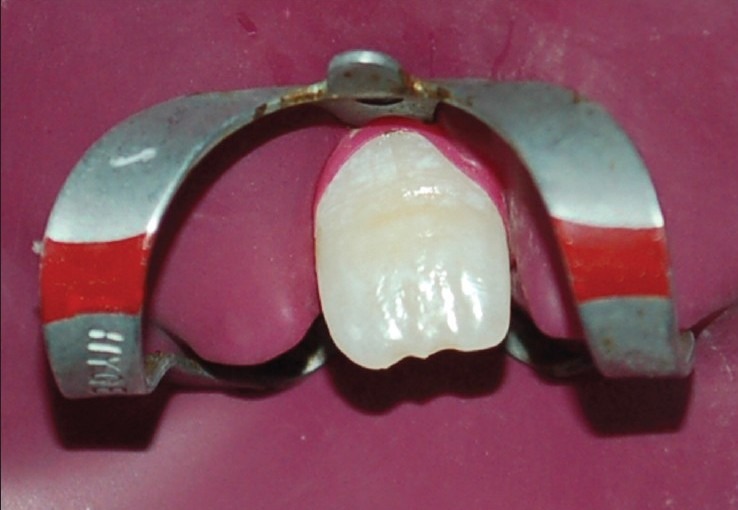
Pre treatment photograph showing White spot lesions
Figure 2.
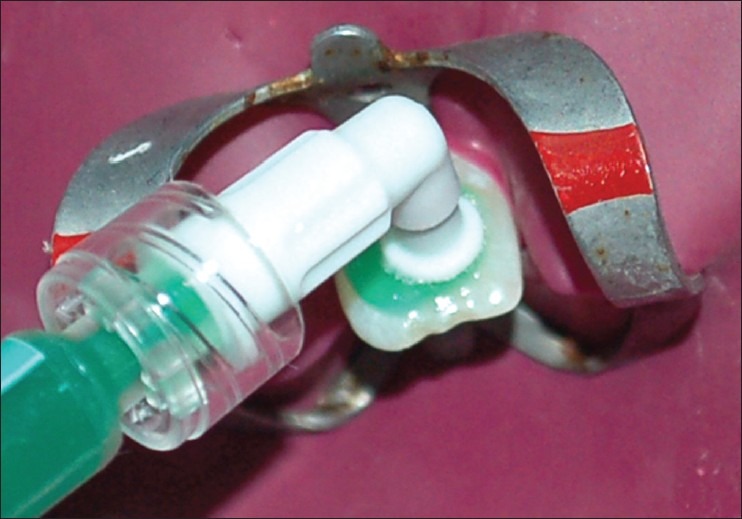
Application of etchant
Figure 3.

Rinsing the etchant
Figure 4.
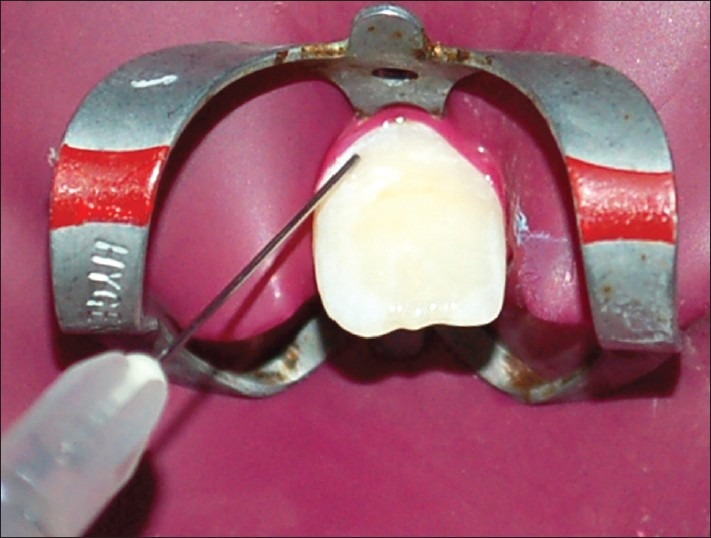
Application of icon dry
Figure 5.

Application of icon infiltrant
Figure 6.
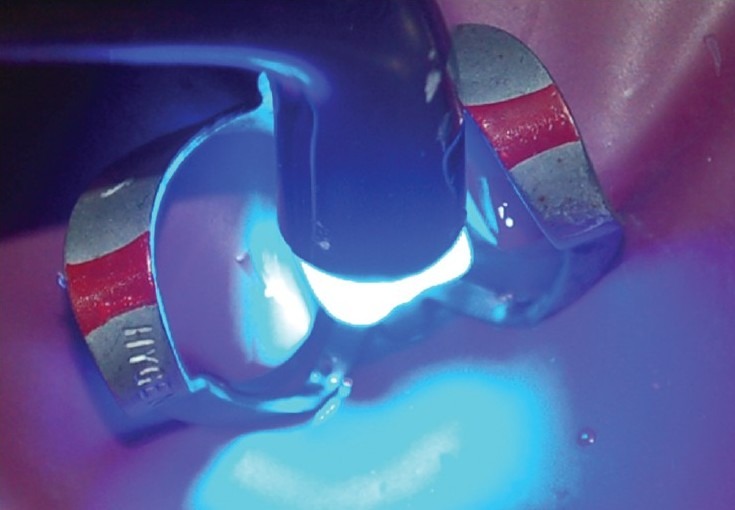
Light curing the infiltrant
Figure 7.
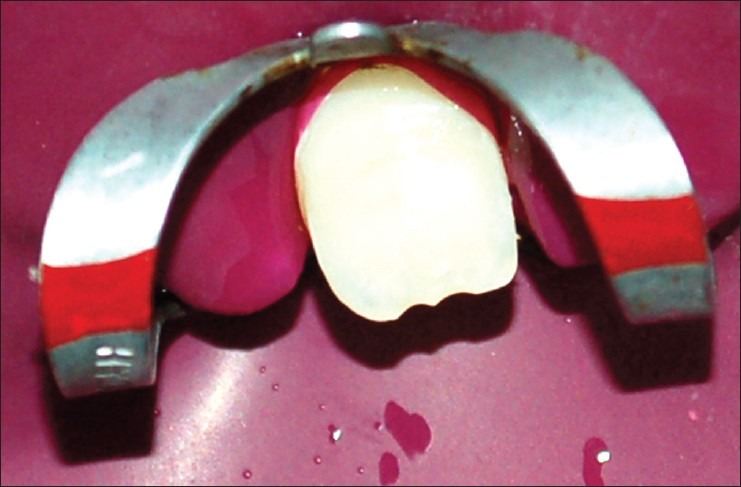
Post treatment showing improved esthetics
Figure 8.
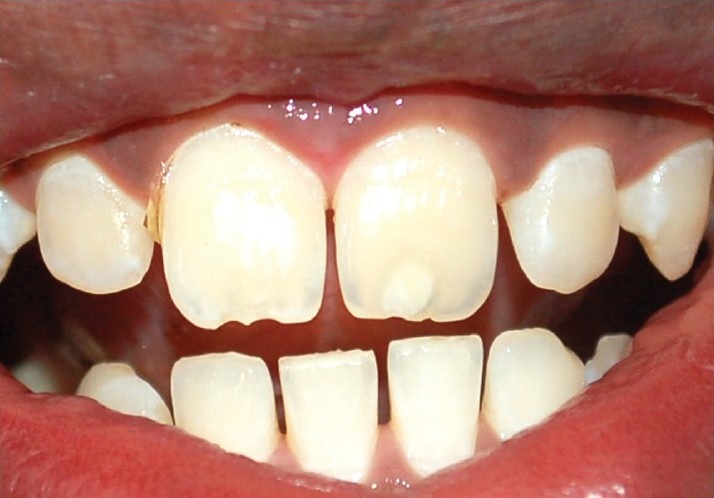
Improved esthetics in the wet environment
Table 1.
L*a*b scores of the patients
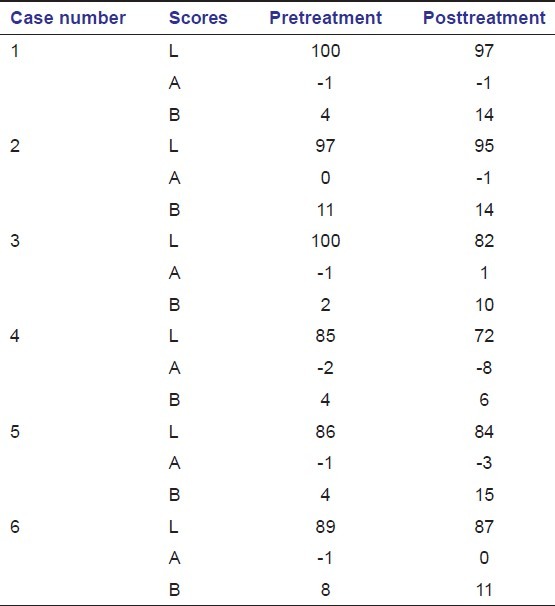
Discussion
The treatment of noncavitated lesions should aim upon arresting the lesion progression and improving the esthetics by diminishing the opacity.[8,9]
Lueckel and Paris[10] emphasized that the original aim of caries infiltration is to arrest the lesion progression by occluding the microporosities that provide diffusion pathways for acids and dissolved minerals.
Infiltrants used in this ICON technique are light curable resins that are optimized for rapid penetration into the capillary structures of the lesion body. These materials exhibit a very low viscosity, low contact angles to the enamel, and high surface tension. These material properties are important for complete penetration of the resin infiltrant into the lesion body of the enamel caries. Further Lueckel and Paris[11,12] demonstrated the inhibition of caries progression both in vitro and in vivo lesions, after the application of ICON infiltrants.
However, for infiltration of the resin, the mineralized intact surface layer hampers the resin from penetrating into the lesion. Hence, this layer is removed by acid etching with 15% hydrochloric acid gel. Application of hydrochloric acid as an etchant has been demonstrated to be superior to 37% phosphoric acid gel in removing the surface layer of natural enamel lesions when applied for 120 seconds. Moreover, in contrast to enamel microabrasion, only 30--40 mm are eroded with this technique, making this technique to be truly microinvasive.
Regarding the optical properties of enamel, sound enamel has refractive index (RI) of 1.62. The microporosities of enamel caries lesions are filled with either a watery medium (RI 1.33) or air (RI 1.0). The difference in refractive indices between the enamel crystals and medium inside the porosities causes light scattering that results in a whitish opaque appearance of these lesions, especially when they are desiccated.
The principle of masking enamel lesions by resin infiltration is based on changes in light scattering within the lesions.[9] The novel technique used involves the infiltration of the carious lesions with resin (RI 1.46) that, in contrast to the watery medium, cannot evaporate. This makes the difference in refractive indices between porosities and enamel to be negligible and lesions appear similar to the surrounding sound enamel. It has a chameleon effect requires no shade matching. Lesions lose their whitish opaque color and blend reasonably well with surrounding natural tooth structure.[7] Hence an immediate improvement in the esthetic appearance was observed.
The CIE L*a*b values were recorded using pretreatment and posttreatment photographs and Δ E was calculated to determine the extent of color change and was observed to be 9.1 suggesting obvious change in the whiteness of the lesion in pre- and posttreatment photographs. Any value > 6 has been shown to correlate with the obvious changes in the color differences when two different photographs are compared.[13]
Conclusion
Caries infiltration is a novel technique that brings out immediate esthetic improvement in the opacity of the white spot lesions. The treatment is done in simple one visit with no drilling or anesthesia while preserving healthy tooth structure. This microinvasive technique is designed to bridge the gap between prevention and restoration by filling and reinforcing the pore system of a noncavitated white spot with a light curable resin. Further long-term studies are required to establish the longevity of the esthetic improvement as achieved by the caries infiltration technique.
Clinical implications and relevance to esthetic dentistry
Dentists have always found it difficult to deal with the white spot lesions in esthetic zones. The preventive noninvasive treatment involves usage of daily fluoride, but it requires a lot of time and patient cooperation. Other treatment procedures like use of composites involve invasive approaches. Hence this microinvasive procedure seems to be a promising solution providing immediate esthetic improvement of white spot lesions.
Footnotes
Source of Support: Nil
Conflict of Interest: None declared.
References
- 1.Subramaniam K, Siswomihardjo W, Sunarintyas S. The effect of different concentrations of Neem (Azadiractha indica) leaves extract on the inhibition of Streptococcus mutans (In vitro) Maj Ked Gigi Dent J. 2005;38:1769. [Google Scholar]
- 2.Burne RA, Marquis RE. Alkali production by oral bacteria and protection against dental caries. FEMS Microbiol Lett. 2000;193:1–6. doi: 10.1111/j.1574-6968.2000.tb09393.x. [DOI] [PubMed] [Google Scholar]
- 3.Allison J, Amundson P, Barsky M, Beers A, Berger A, Biles J, et al. The disease dental caries: Risk assessment/strategies of disease control. http://www1.umn.edu/dental/courses/dent_6806fall04/paper 1/paper1.pdf .
- 4.Glazer HS. Treating white spots: New caries infiltration technique. 2009. http://www.dentistrytoday.com/restorative/minimallyinvasivedentistry/1492 . [PubMed]
- 5.Young DA, Kutsch VK, Whitehouse J. A clinician's guide to CAMBRA: A simple approach. Compend Contin Educ Dent. 2009;30:92–105. [PubMed] [Google Scholar]
- 6.Hammad SM, El Banna M, El Zayat I, Mohsen MA. Effect of resin infiltration on white spot lesions after debonding orthodontic brackets. Am J Dent. 2012;25:3–8. [PubMed] [Google Scholar]
- 7.Gerard Kugel G, Arsenaul P, Papas A. Treatment modalities for caries management, including a new resin infiltration system. Compendium. 2009;30:1–10. [PubMed] [Google Scholar]
- 8.Sapir S, Shapira J. Clinical solutions for developmental defects of enamel and dentin in children. Pediatr Dent. 2007;29:330–6. [PubMed] [Google Scholar]
- 9.Paris S, Meyer-Lueckel H. Masking of labial enamel white spot lesions by resin infiltration: A clinical report. Quintessence Int. 2009;40:713–8. [PubMed] [Google Scholar]
- 10.Meyer-Luekel H, Paris S. Progression of artificial enamel caries lesions after infiltration with experimental light curing resins. Caries Res. 2008;42:117–24. doi: 10.1159/000118631. [DOI] [PubMed] [Google Scholar]
- 11.Mueller J, Meyer Luekel H, Paris S, Hopfenmueller W, Kielbassa AM. Inhibition of lesion progression by penetration of resins in vitro: Influence of the application procedure. Oper Dent. 2006;31:338–45. doi: 10.2341/05-39. [DOI] [PubMed] [Google Scholar]
- 12.Paris S, Meyer-Lueckel H. Inhibition of caries progression by resin infiltration in situ. Caries Res. 2010;44(1):47–54. doi: 10.1159/000275917. [DOI] [PubMed] [Google Scholar]
- 13.Yamanel K, Caglar A, Özcan M, Gulsah K, Bagis B. Assessment of color parameters of composite resin shade guides using digital imaging versus colorimeter. J Esthet Restor Dent. 2010;22:379–90. doi: 10.1111/j.1708-8240.2010.00370.x. [DOI] [PubMed] [Google Scholar]


